We’ve been testing the FLOWBIO S1 sensor at our Precision Performance Lab in Christchurch, Dorset.
This blog details our initial thoughts on the S1 and we’ll continue to provide updates as we gather more data. If you have any specific questions, would like some help with interpreting your results, or want to share your experiences with the S1 or other wearable sweat sensors, consider getting in touch with us via a free 20-minute video call or by emailing us at hello@pfandh.com.
The key takeaways
The FLOWBIO S1 is a reusable, wearable device that estimates how much fluid and sodium you lose during exercise. It aims to improve performance and recovery by helping you understand your personalised sweat rate and sweat sodium losses across various conditions.
We tested the S1 across both cool and hot conditions to assess its accuracy in estimating sweat rate and sodium losses:
- On average, the device underestimated sweat rate by 0.44 litres per hour (L/h) as compared to pre- and post-exercise body mass change
- And it overestimated sweat sodium concentration by an average of 413 milligrams per litre of fluid (mg/L) when compared to readings obtained from the Precision Fuel & Hydration desktop Sweat Analyzer (PF&H Sweat Analyzer)
- It appeared to be more accurate at estimating sweat rate at lower rates of sweat loss, but struggled with higher sweat rates
- In its current state, the S1 provides potentially useful insight into your sweat sodium concentration and sweat rate, especially in situations where you’re not able to utilise ‘gold standard’ sweat rate and sweat sodium concentration tests
Whilst the data provided by the S1 is not currently available in real-time, it is measured in real-time and we have word that the data will be available soon. This is definitely technology to watch as it matures
We were thoroughly impressed by the FLOWBIO customer support team’s responsiveness when we had questions about the S1, and their own commitment to improvement as we continue to test their device
Last updated: January 2025
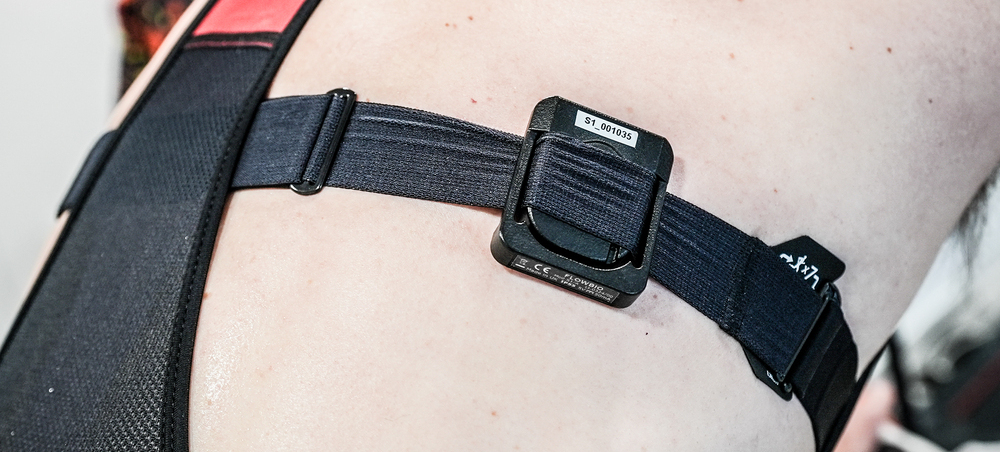
The S1 essentials
What does it do?
The S1 estimates your:
- Net sodium loss (milligrams)
- Sweat sodium concentration (milligrams per litre)
- Whole-body (total) sweat loss (litres)
- Whole-body (total) sweat rate (litres per hour)
The S1 app summarises this data simply and clearly. But it doesn’t yet offer a ‘sweat profile’, or provide any specific post-exercise hydration recommendations from a recovery point-of-view, which we would love to see in the future. For example, a ‘sweat profile’ might categorise you as a salty or not very salty sweater, and include where your sweat rate falls in similar low, medium or high categories.
What does it cost?
As of January 2025, the device costs £379 (USD$462).
What’s included?
- 1 x FLOWBIO S1 device
- 1 x USB-C charging cable
- 2 x Straps
- 1 x Cleaning bottles
The S1 is entirely reusable with no single-use components or additional memberships.
How to wear the S1?
It can be worn on the upper back or arm. It has been designed to attach to your arm or chest-based strap if you wear a heart rate monitor, or you can use the provided strap. The sensor must be worn on a flat part of your skin surface and should be tightly secured to avoid any possible movement that could affect the reading. When removing the device from the body, end the session on the app before removing it to prevent contamination of sweat from other parts of the body.
How does the device work?
The S1 doesn’t actually measure your sweat rate, but rather it uses a combination of measurements and proprietary algorithms to estimate your sweat loss.
To estimate your whole-body sweat rate, the S1 combines measurements of your local sweat rate and skin temperature on the underside of the device, with the proprietary equations / algorithms that factor in the intensity of your exercise session, and environmental conditions.
For your sweat sodium concentration, there’s a sodium analyser in the sweat duct which assesses the amount of sodium per litre in your sample to measure how ‘salty’ your sweat is.
Hardware maintenance and session set-up:
For sufficient sweat rate information to be presented by the S1, it’s recommended that exercise duration should last at least ~45 minutes.
The S1 collects sweat through a channel that allows sweat secreted onto the skin surface to be passed through the sweat channel. As a result of the free-flowing channel design, there should be no issue with the S1 overflowing (i.e., the measured local ‘sweat rate’ by some devices could be theoretically maxed out) as is the potential with some other wearable sweat sensor designs.
FLOWBIO provides one cleaning bottle in the box to rinse the S1's sensitive electronics for general maintenance and when switching between users. We’d suggest rinsing the device periodically even if you don’t use the device between users, to help extend the life of the specialised sensors, although FLOWBIO suggests this is not necessary. FLOWBIO recommends that you rinse the sweat ‘channel’ (which is visible on the side of the device that’s in contact with the skin) with the cleaning bottle in three scenarios:
- If you’re notified to do so (rinse with both water then air)
- If you notice sweat/sodium in the channel from a previous session (rinse with just air for any unevaporated sweat)
- If you use the device between individuals (rinse with both water and air)
Software nitty gritty:
At the time of writing, the S1 Companion application is limited to iOS users.
The S1 connects via Bluetooth to the ‘S1 Companion’ application and is charged using a USB-C charging port. According to FLOWBIO, the device has a battery life of 100+ hours. We didn’t test this directly, but we were impressed by its battery life.
It requires activities to be recorded on a compatible fitness tracker (Garmin, Wahoo, Zwift, Polar, Coros, etc.), as the S1 pulls data collected from these activity files for its calculations, and the S1 cannot record an activity independently.
After the session is completed and uploaded by the respective fitness tracker, there’s usually a delay of a few minutes until the data and final outputs appear in the S1 app.
The app currently offers three exercise types: cycling, running, or walking, all of which can be completed indoors or outdoors.
The device is waterproof and can be submerged and used during swimming, but it won’t collect data or provide a report for exercise during this time.
Following completion of the exercise, there’s the option to input the environmental conditions (temperature) and location (where on the body) the device was worn, which should both be completed for the best results. Whilst data is acquired live, the device doesn’t currently report real-time recommendations or notifications.
The S1 can be out of Bluetooth range of your device and still collect the sweat information locally (for up to 48 hours of training data) before uploading the activity, and FLOWBIO recommends that the device is synched after every activity.
The S1 has a ‘shake to wake’ activation mechanism - shaking the device a few times turns it on, so it can be ‘found’ in the app for connection purposes. Once turned on and connected, the app shows the device ID, its battery life and a prediction in hours for how long this will last.
The ‘Home’ screen then shows if the device is connected, and has the option to either ‘sync’ it, or start / end a session. There’s a small section on the home screen with links to videos further explaining how to use the devices.
The S1 also includes an estimate of your metabolic and respiratory mass losses during exercise. Whilst the majority of an athlete's mass is lost via sweat, metabolic and respiratory mass losses can be important to account for, especially over longer durations. This can be even more important if you exercise in particularly cool and / or dry environments as non-sweat losses can represent a higher proportion of your mass losses.
Fluid lost through respiration is determined by the rate of air movement in and out of the lungs, as well as the temperature and humidity of the environment you’re working in. And metabolic mass loss in simple terms, is mostly determined by how much you weigh, how fast you’re running or how much power you’re producing.
Thankfully, we can estimate these non-sweat losses using a relatively simple equation:
Mᵣₑₛₚ= M X 0.0002
Where: Mᵣₑₛₚ is respiratory mass loss (in kg) and M is energy expenditure (in kcal).
To compare apples with apples, as FLOWBIO do, we made sure to account for these losses by deducting them from the total measured fluid loss (by body mass change). As this method doesn’t account for temperature and humidity, in extremely warm, cold, dry or humid environments, there will be increased error in these calculations. To put this concept into context, non-sweat losses (comprised of metabolic and respiratory mass losses) for an hour long activity which burned 750kcal could be in the region of 0.15kg over that hour. FLOWBIO classify these losses as non-sweat losses, but the larger proportion of metabolic and respiratory mass losses is usually respiratory water loss. Therefore, it's important to note that these losses are still fluid and therefore do need to be replaced to support your hydration status.
An algorithm is used which combines ambient temperature, skin temperature, previous S1 data (if available), position on the body, exercise intensity and duration to generate the outputs. Differences in these parameters will modify the result seen in the app. It’s important that when you’re using the device, you pay close attention to input these variables correctly. One strange omission from the indoor data requirements is the absence of relative humidity, which is known to strongly affect sweating efficiency (the proportion of sweat secreted onto the skin surface versus the proportion of sweat that is evaporated) and in turn, whole-body sweat rate.
What are the unique aspects of this device?
The S1 uses a custom 3D-printed chassis and unique components for measuring local sweat rate and sweat sodium concentration. Potentially similar biophysical models for predicting sweat loss exist in research literature, which uses similar data as the S1. Theoretically, this device's biggest advantage over biophysical models (i.e. models that account for the individual (exercise intensity / body shape and size) and environmental conditions) of sweat rate is the measure of single-site skin temperature and local sweat rate and sodium, which should improve the device's accuracy, especially across changeable conditions or where sweating stops and starts.
FLOWBIO Customer support:
Throughout our testing, we have been in touch with the FLOWBIO team to receive support via troubleshooting and regular communication as needed. We’re thoroughly impressed with the knowledge and responsiveness of their team as they supported us throughout. They seem geared up and ready to push this device even further and we won’t be surprised if big improvements come quickly.
FLOWBIO’s Hydration Planner:
At the time of writing, FLOWBIO released a hydration planning tool for users of the S1 (who have completed at least three sessions with the device).
Users can forecast their fluid and sodium needs using a few key pieces of data, including the expected ambient temperature and duration; if you’re cycling you need to enter your speed, and your pace for running. Using your past sessions and your planned activity, the device will then forecast your hydration needs for the upcoming session.
If you don’t have an S1, you can head to our free Fuel & Hydration Planner to estimate your carb, fluid and sodium needs for an upcoming event.
How accurate is the S1?
Six members of the PF&H team have used the device during a variety of bike and run sessions over five months.
Of the 62 completed tests, 20 consisted of low- to moderate-intensity running which lasted 38-62 minutes. The remaining 42 were all completed while cycling, mostly at a low- to moderate intensity, with some consisting of intervals or short efforts. The session lengths ranged from 50 minutes to five hours.
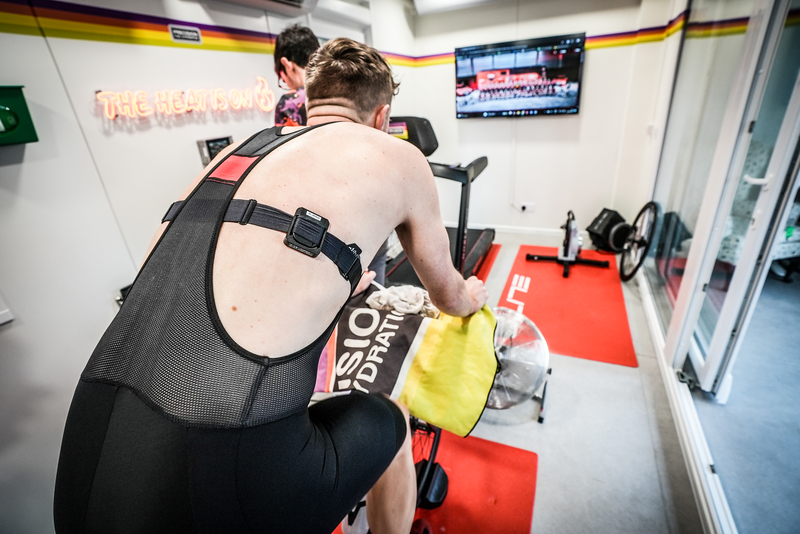
Data was collected in a range of conditions, with an average temperature of 24.6ºC / 76.2ºF with 54% relative humidity. This included a low of 13ºC / 55.4ºF with 86% relative humidity, and a high of 42ºC / 107.6ºF with 38% relative humidity.
3 key findings:
- The S1 overestimated sweat sodium concentration (i.e. how much sodium you lose in your sweat) by an average of 413mg/L compared to sweat collected during exercise and measured using our PF&H Sweat Analyzer
- We collected sweat from the inside of the upper forearm as we normally do during our Sweat Test with a macroduct (sweat collection device), but this time during exercise.
- The area where the macroduct was placed was wiped with gauze, and then with gauze and deionised water to prepare the skin surface. The macroduct was then placed immediately onto the skin surface and sampled through our PF&H Sweat Analyzer to assess sweat sodium concentration. The macroduct was removed prior to it overflowing.
- Conversely, the S1 consistently underreported sweat rate (i.e. how much fluid you lose) by an average of 0.44L/h compared to sweat rate measured using pre- and post-exercise body mass measures. And in an extreme case, sweat rate was underestimated by 1.55L/h
- The sensor failed to record any data or failed to upload in 17 sessions (a 21% failure rate), which reduced our sample from 79 to 62
Results

Sweat Sodium Concentration:
As our convenient, at-rest, pilocarpine-based Sweat Test maximally stimulates sweating to inform you of your sweat sodium concentration while racing (usually at higher sweat rates), our Sweat Test value is often higher than what you’d expect to see at low sweat rates. Sweat sodium concentration is linked to sweat rate because the sweat glands have less time to reclaim electrolytes at higher sweat rates, leading to higher sweat sodium concentrations (see Fig. 1).
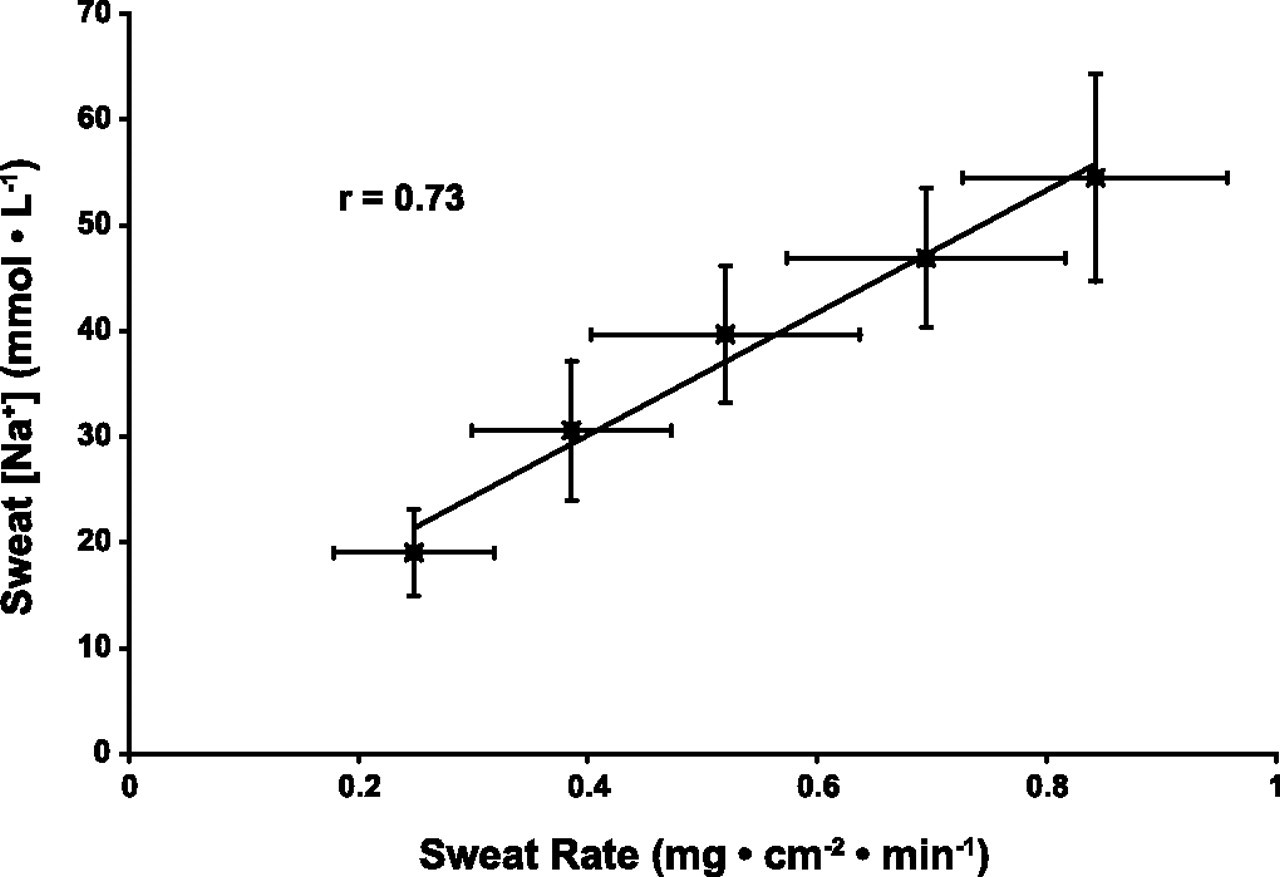
We know that how much sodium you lose in your sweat, independent of your sweat rate, is largely genetically determined. So, if you do observe small fluctuations in your sweat sodium concentration throughout and between exercise sessions with the S1, this is unsurprising. It’s likely that your whole-body sweat rate either fluctuated during your session (leading to transient changes) and/or was different between exercise sessions (and you’re no longer comparing apples with apples).
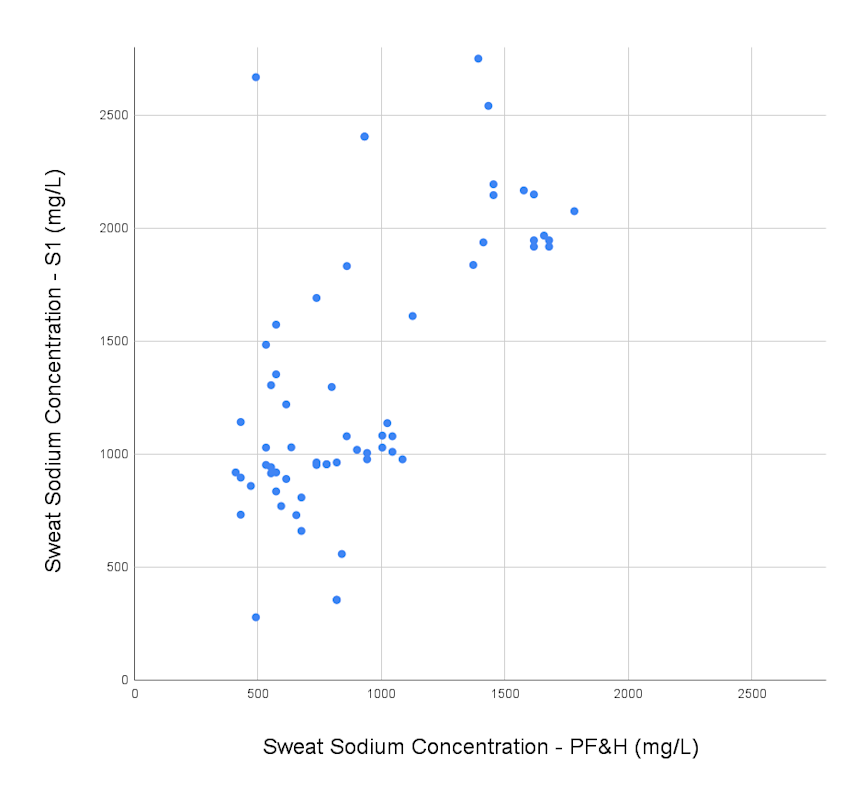
In our data, the S1 appears to overestimate your sweat sodium score, potentially due to underestimating your sweat rate. If you don’t have access to a reference sweat sodium test such as a PF&H Sweat Test Center, or if you’d like to try to understand your during-exercise sweat sodium loss after several uses, the S1 may provide useful information that you could use to implement during- and post-exercise hydration strategies to match your sodium losses.
We’d suggest that if you see a large change in your reported sweat sodium concentration when using the S1, simply repeat that session a couple more times as your sweat sodium score doesn’t usually change drastically unless you compare it between sessions where you had significantly different rates of whole-body sweat loss. (i.e. very low to very high sweat rates).
Sweat Rate:
The guidelines for the amount of dehydration you can tolerate before it negatively impacts your performance and health have changed over the years. Not that long ago, the American College of Sports Medicine (ACSM) recommended replacing 100% of fluid lost through sweat to maintain performance. We now know this isn’t required and can even be dangerous. This recommendation ultimately led to many athletes experiencing the negative effects of hyponatremia (i.e. low blood sodium levels), which is mostly caused by excessive drinking of plain water and the ACSM subsequently rolled back this recommendation.
Sweat rate is highly variable within and between individuals. Research shows that sweat rate is driven by factors such as your metabolic rate, exercise modality (e.g. bike vs run), environmental conditions, type of clothing you wear, your body shape and size, and your level of heat adaptation (heat acclimation/acclimatisation status).
The data given by the S1 could be used to understand your rate of fluid loss when working at various intensities and in different environmental conditions to inform your fluid replacement strategy.
To evaluate the data from the FLOWBIO S1, we measured sweat rate through nude body mass measurements pre- and post-exercise, along with any fluid and fuel consumed as detailed in this how to measure your sweat rate protocol.
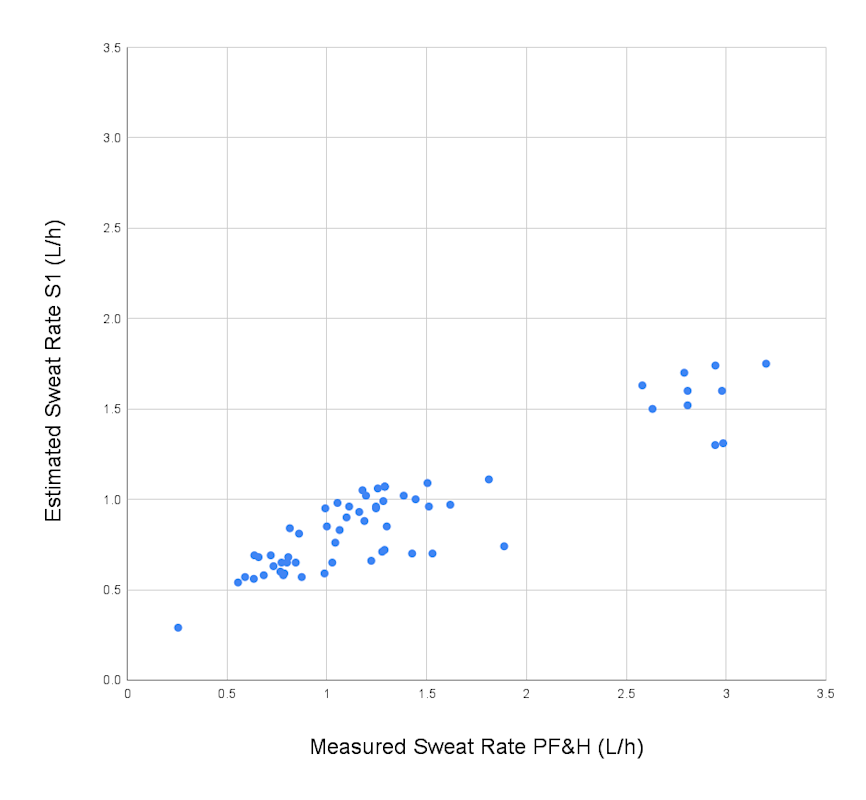
During our testing, the S1 consistently underestimated sweat rate by an average of 0.44L/h. We found that the S1 underreported sweat volume loss for all athletes in our group, especially at higher measured sweat rates.
The S1 tended to report more accurate sweat rates for athletes losing 1L/h or less. For example, Tash had a sweat rate that averaged ~1.05L/h, ± 0.33 but the S1 reported a mean sweat rate of 0.78L/h (-0.26L/h lower than her actual sweat rate).
Those with high sweat rates saw the largest amount of error from the S1. During his heat acclimation sessions at our Precision Performance Lab ahead of the World Triathlon Championships in Hawaii, Ant exercised at ~41ºC (105ºF) and lost an average of 2.87L/h in every session! While the S1 reported an average of 1.57L/h, which means the S1 underestimated sweat losses by 1.3L/h.
It’s beyond 1L/h where adequately replacing your losses becomes increasingly relevant as you’re likely exercising in hotter and humid conditions, where dehydration can harm your performance and health.
Underestimating your sweat rate by almost half a litre per hour on average could have a pretty big impact on your hydration strategy, especially during longer races where your net sweat losses will build up.
If you use the S1 to measure your sweat rate, it’s worth conducting your own sweat rate measurements to build confidence and understanding of the S1’s data, especially if you’re someone who experiences a high sweat rate regularly.
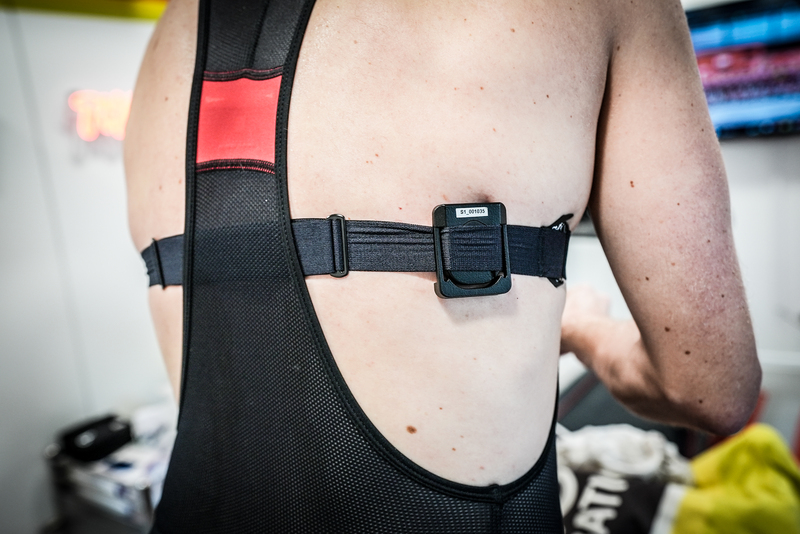
How to use the S1
The S1 provides a useful insight into your sweat sodium concentration and sweat rate when more accurate and reliable sweat rate measurements and/or laboratory-grade sweat analysers are unavailable or impractical. It isn’t yet able to replace gold standard methods for athletes, but the team at FLOWBIO are continuing to make significant progress and improvements to the S1.
The consistent underestimation of sweat rate in our data suggests that their algorithm still has room for improvement. Given the consistency of these underestimations, this problem is likely very solvable in future updates.
Measuring sweat rate by observing changes in body mass before and after exercise is neither expensive nor challenging and is possibly the most accurate, so it should probably remain the serious athletes’ go-to method for collecting sweat rate data for now.
If you decide to use an S1, we’d recommend using it a few times to gather your own sweat sodium concentration data and take an average to help inform your electrolyte replacement strategy, given the variability compared to our reference PF&H Sweat Analyzer.
When you’re exercising at a high intensity in warmer and/or more humid conditions, sweat rates are higher (>1.0L/h), and the risk of dehydration is more likely. Having quality sweat rate and sweat sodium concentration data in these scenarios will be where devices like the S1 could come to the fore.
Here’s our recommended set of guidelines for how to use the S1 to get the most out of the device:
- Complete a minimum of 10 tests using the S1, cleaning the sensor between sessions
- Ensure that these vary in intensity, duration and type of exercise session
- For every session, record your own sweat rate data
- Take an average of the sodium and fluid losses and refer to your gathered sweat rate data
What do we plan to do next?
We plan to continue stress-testing the S1 in hot and humid conditions at our Precision Performance Lab and we’ll update this blog with more data as it becomes available. Further to that, we’ll keep an eye out for future software and hardware updates that come out and will update this blog with our latest thoughts as this device continues to progress and improve.
We shared this article and our data with FLOWBIO before publishing and this was their response:
"FLOWBIO would like to thank the team at Precision Fuel & Hydration for their assessment of our S1. We know how much time, effort, and of course sweat, it takes to do these physiological measurements. The S1 aims to be a tool to help take out the guesswork when it comes to hydration, providing our users with real-time, multi-point data acquisition throughout your training; helping you prepare, recover and perform at your best.
"The S1, like almost all wearable tech, is not a replacement for gold-standard lab measurements, rather it tries to facilitate measurements in real-world applications where access to gold-standard equipment is not available; simplifying the data acquisition process.
"We have the user and scientific community in our DNA and at the time of writing have several validation studies due for publication. We will share these with PF&H when they become available.
"We would like to take the opportunity to thank all our users for their support throughout our development, including the team at PF&H. It is all of your sweat and feedback that helps us to continuously improve our technology and help all our users get the best data."
